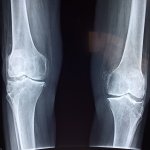There could be a link between how much the knee adducts during gait and the health of knee cartilage.
A new study examined the relationship between cartilage thickness and gait mechanics in 744 knees. In patients with late stage osteoarthritis, those people who had higher levels of knee adduction during gait had lower levels of medial-to-lateral cartilage thickness ratios. Interestingly, in subjects with healthy knees, more knee adduction during gait was actually associated with greater thickness of cartilage.
Conclusions
It is difficult to draw any firm conclusions based on the correlational observations of this study. If knee adduction during gait were universally harmful, then it would be highly surprising to see that the subjects with healthy knees who adducted had higher cartilage thickness. One possibility is that in a person with healthy tissue remodeling, the extra load on the joint induced by the altered gait may lead to a thickening of the cartilage. On the other hand, in those who have aberrant tissue remodeling, the extra load will lead to overloading of the joint and gradual erosion of the cartilage. This would fit with the theory that arthritis is ultimately a disease of aberrant remodeling rather than simply wear and tear. Future studies would be useful to further elucidate in what circumstances the increased load on a joint leads to degeneration.
References
